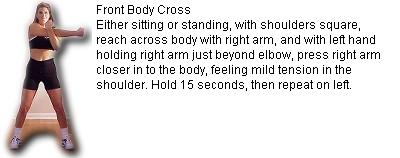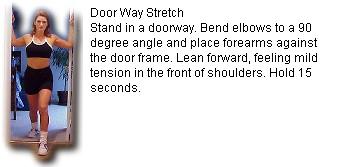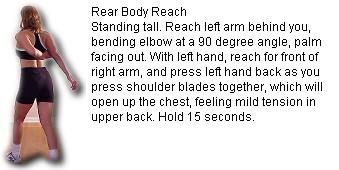The
right way to stretch
-
Breathe easily
-
Relax
-
Tune into your body
-
Focus on muscles and joints being
stretched
-
Feel the stretch
-
Be guided by the feel of the stretch
-
No bouncing!
-
No pain!
The
wrong way to stretch
-
Holding your breath
-
Being in a hurry
-
Not being focused on your body
-
Stretching while tense
-
Bouncing
-
Stretching to the point of pain
Two
Phases
There are
two phases to each stretch: the easy stretch and the developmental
stretch. They are done one after the other.
The
Easy Stretch
Stretch
until you feel a slight mild tension and hold for 5–10 seconds. Relax.
As you hold the stretch, the feeling of tension should diminish. If it
doesn’t, ease off slightly into a more comfortable stretch. The easy
stretch maintains flexibility, loosens muscles and tight tendons, and
reduces muscle tension.
The
Developmental Stretch
Now, move
a fraction of an inch farther into the stretch until you feel mild
tension again. Hold for 5 to 10 seconds. Again, the feeling should
diminish or stay the same. If the tension increases or becomes painful,
you are overstretching — back off into a more comfortable stretch. The
developmental stretch further reduces tension and increases flexibility.
Keep
the following points in mind
-
Always stretch within your comfortable
limits, never to the point of pain.
-
Breathe slowly, rhythmically and under
control. Do not hold your breath.
-
Take your time. The long-sustained, mild
stretch reduces unwanted muscle tension and tightness.
-
Do not compare yourself with others. We
are all different. Comparisons may lead to overstretching.
-
If you are stretching correctly, the
stretch feeling should slightly subside as you hold the stretch.
-
Any stretch that grows in intensity or
becomes painful means you are overstretching — the drastic stretch.
(See page 13.)
Pay
attention to how each stretch feels
Hold only
stretch tensions that feel good. Relax while you concentrate on the area
being stretched.
Important
No
bouncing
No pain
How
far should I stretch?
Your body
is different every day. Be guided by how the stretch feels.
Stretching is not exercise!
You are
stretching, not exercising. You don’t need to push it. Stretching is a
mild, gentle activity.
Give
it 2 to 3 weeks for benefits
The
benefits come from regularity. Stick with it and see how you feel in a
few weeks.




